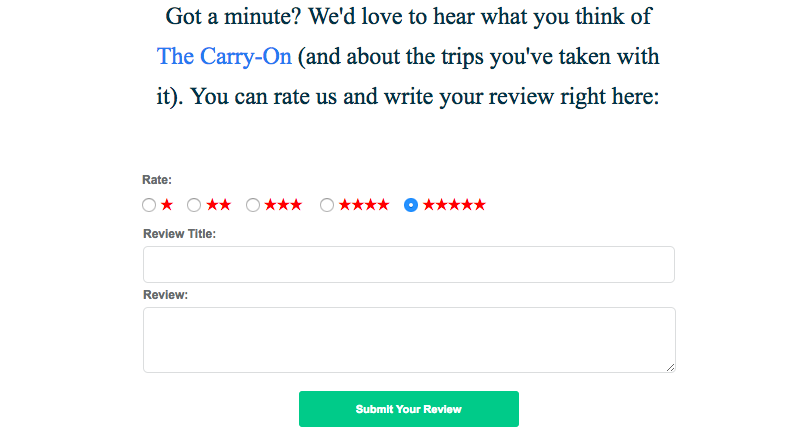
3 Ways to Get More Reviews from Your Customers
As we’ve plugged our lives into smartphones, wearables, computers, and virtual assistants, many of us have accidentally entered a state of perpetual information fatigue.
As we dash between work emails, bills, and personal notes, it’s easy to send emails from brands straight to the virtual rubbish bin.
For e-commerce businesses, this presents a major challenge. Businesses want to build relationships with customers, but how can they get–and keep–customers’ attention?
Online reviews are a must-have website feature that e-commerce businesses can become closer to their customers. Not only do reviews engage customers after a purchase, but they also serve as an important trust signal that might persuade future shoppers to make a purchase.
However, a recent survey found that a whopping 81% of customers simply don’t write reviews, even if they rely on reviews themselves while making purchasing decisions.
Even among the 19% of frequent reviewers, it’s unlikely that most of them have the time or energy to review every online purchase.
By examining key factors–including lack of time, lack of incentives, and email outreach–that prevent customers from writing reviews of their purchases, e-commerce businesses can take steps to address obstacles and persuade more customers to write reviews.
1. Make reviewing quick and easy
Not surprisingly, a perceived lack of time prevents approximately 1 in 5 shoppers from writing a review. One factor could be the intimidating nature of starting with a blank page.
Let’s say you recently purchased a tent for camping trips with your family. If you were asked about your experience with the new tent, would you write about whether the materials used to make the tent lived up to the website’s promises?
Would you write about how difficult it was to hammer the stakes into the ground, or would you second guess whether the cold ground was to blame? Would you write about how much fun it was to take your kids camping for the first time?
Given too much freedom, it’s easy for customers to become paralyzed by indecision. A seemingly simple question can become fraught with too many options, especially if a customer isn’t completely sure what information a company is looking for.
On the opposite extreme, there is limited value in asking customers questions that can be answered with a simple yes or no, or with just a numerical ranking of satisfaction. Customers who read reviews are typically looking for context and a story about how a product made a positive difference in a previous customer’s life.
Instead, e-commerce businesses should request reviews by asking questions that fall in between these two extremes.
After conducting extensive online research, I recently purchased a new suitcase. About a month after my purchase, I received an email from the company requesting a review:
The email boldly pre-filled a 5-star rating and requested specific information that helped me focus my thoughts quickly.
Additionally, the company allowed me to write a review without ever leaving my email, which saved time by not requiring me to open a new tab or risk losing focus on managing my inbox.
Try asking your customers for specific feedback about:
- Feel and durability of materials
- Size and fit for clothing and shoes
- How colours appeared in person
- Stories of how they used the product
By guiding customers’ thoughts to specific questions and using tools that can gather reviews without forcing them to navigate to a different web page, you can cut down on the time it takes customers to write reviews.
By making it quick and easy for customers to share their thoughts, you can reduce a key obstacle that prevents customers from reviewing your products.
2. Try offering a small incentive
There’s a reason dentists and doctors offer children a sticker or treat for being obedient during an appointment. A little encouragement can help make an unpalatable task seem more rewarding.
This is also true for e-commerce businesses. Among customers who do write reviews, some (5%) are persuaded because a company offers an incentive in exchange for a review.
An additional 10% of shoppers who don’t usually write reviews say that they would write a review if it made them eligible to receive an incentive.
E-commerce businesses can’t hand their customers a sticker in exchange for writing a review, but they can offer some digital treats–including ones that can encourage future purchases.
Common incentives include a small discount off a future purchase or entry into a contest.
Here’s an example of a review for Vans sneakers that was submitted to Nordstrom in exchange for a sweepstakes entry:
That being said, offering incentives comes with a few caveats. Nordstrom discloses which reviews are submitted in exchange for an incentive to provide transparency to online shoppers.
E-commerce businesses that enter customers in contests in exchange for reviews should do the same in order to retain the key value of online reviews, which is building trust with customers.
Additionally, e-commerce businesses should never pay for positive reviews or hinge eligibility for an incentive on a customer’s willingness to write a positive review. Not only will this prevent you from collecting authentic reviews, it is illegal in some countries.
Finally, ecommerce businesses must consider how incentives might affect their profit margins. Offering incentives that are too generous could quickly erode revenue.
Overall, incentives can be a compelling way to reward customers who write reviews of their purchases.
3. Send a reminder email
We’ve already covered the pain points that make it difficult to get your customers’ attention after a purchase has been completed. But despite stiff competition for customers’ attention, email outreach actually does work.
Among online shoppers who recently wrote a review, nearly a quarter (23%) were nudged by an email.
There are three keys to success when it comes to sending emails that will actually engage your customers:
A. Experiment with timing
Last year, I received an email from a company I didn’t recognize, requesting a review of a product I had purchased. I deleted the email and moved on with my day, but it stuck in my mind. What had I purchased?
Later, I realized what had happened. I had made a purchase through Amazon without paying attention to the company’s name, and they had waited over a month to contact me for a review.
At that point, the product no longer felt new to me, and with the purchase so distant in my memory, I didn’t feel motivated to offer feedback.
A month might have been too long to wait in this case, but when I purchased the suitcase I mentioned earlier, it was the perfect amount of time to take the suitcase on a trip I had planned.
The moral of the story? Ecommerce businesses should be aware of how their customers use their products and experiment with how long they wait to send an email requesting a review after a customer purchases an item.
In general, it’s best to wait until you know a product has been delivered and then build in a week or so for your customers to use their new product, but this can vary depending on the type of product or customer.
B. Offer solutions
Experts recommend one extra step that can change the way companies request reviews. Before asking a customer to write a review, check in to see if they ran into any issues with the product they purchased.
My colleague recently had a package delivered to work that was accidentally packed with only bubble wrap. The company had forgotten to include the item he purchased!
Everyone understands that these kinds of mistakes happen, but among customers who receive an erroneous package, an initial post-purchase email making sure that the order was fulfilled correctly and the product was satisfactory can work wonders. This kind of outreach lets them know that your company cares about their experience after a sale has been made.
By comparison, an email requesting a review for a bungled delivery is unlikely to be well-received by a customer who is already experiencing inconvenience.
C. Request reviews from satisfied customers
Happy customers are most likely to become your company’s most loyal reviewers. One third (33%) of customers who write reviews want to share their satisfaction with a product, compared to only 2% who bother to write a review after a negative experience.
After providing solutions to dissatisfied customers during your first round of post-purchase email outreach, you’ll have a better sense of which customers you should target with requests for reviews.
If something in your process has gone wrong, you can always reach out to dissatisfied customers to request feedback that will be used internally to strengthen your ecommerce business (an advantage over brick and mortar stores).
With these strategies, you can ensure your email outreach converts into more reviews rather than ending up in the trash.
Related article: How to Deal with Negative Reviews
With simple changes, ecommerce businesses can begin collecting more reviews
Your customers are busy, and there are dozens of other people and companies competing for their attention on- and offline.
However, small changes can help your ecommerce business avoid common the common pain points that prevent customers from writing reviews. To recap:
- Ask for specific feedback rather than posing open-ended questions.
- Allow customers to provide feedback directly in an email to save time.
- Consider offering incentives that encourage customers to return for future purchases.
- Offer to fix any problems customers may have experienced before soliciting reviews.
- Focus on requesting reviews from satisfied customers.
With these tips in mind, you can update your ecommerce business’ plan for collecting customer reviews with confidence.
You read a lot. We like that
Want to take your online business to the next level? Get the tips and insights that matter.




